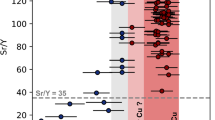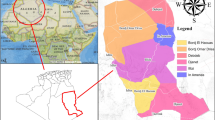Abstract
Land subsidence is a geo-hazard that leads to slow or rapid decrease in ground level. This can result in geological, environmental, hydrogeological, and economic impacts. Land subsidence has already occurred in more than 300 plains in Iran. Semnan plain is one of the most important areas undergoing this phenomenon. In general, miscellaneous methods have been employed around the world to assess land subsidence susceptibility. In this study, support vector machine and weights of evidence Bayesian theory were applied to assess land subsidence susceptibility. In the first step, the required information on the history of subsidence in the study area was provided. Locations of the land subsidence were specified by Landsat 8 satellite images and field surveys. Twelve conditioning factors from different basic layers including topography, geology, land use, and groundwater table were considered for modeling. Spatial correlation between land subsidence locations and effective factors was calculated using weights of evidence Bayesian theory. Land subsidence susceptibility maps were created using support vector machine and weights of evidence models. ROC curve, sensitivity, specificity, Cohen’s Kappa index, and fourfold cross-validation were employed to validate the obtained land subsidence susceptibility maps. In Semnan plain, AUC for the support vector machine and weights of evidence models was 0.748 and 0.726, respectively, demonstrating that the given models hold an acceptable accuracy for land subsidence susceptibility mapping; however, the accuracy of the support vector machine is higher than that of weights of evidence model. Results of this research can help policy makers as well as environmental and urban planners.













Similar content being viewed by others
References
Amiri M, Pourghaemi HR, Ghanbarian GA, Afzali SF (2019) Assessment of the importance of gully erosion effective factors using Boruta algorithm and its spatial modeling and mapping using three machine learning algorithms. Geoderma 340:55–69
Aobpaet A, Cuenca MC, Hooper A, Trisirisatawong I (2013) InSAR time-series analysis of land subsidence in Bangkok, Thailand. Int J Remote Sens 34:2969–2982
Bathrellos GD, Skilodimou HD, Chousianitis K, Youssef AM, Pradhan B (2017) Suitability estimation for urban development using multi-hazard assessment map. Sci Total Environ 575:119–134
Clarke B, Fokoue E, Zhang HH (2009) Principles and theory for data mining and machine learning. Springer, London
Cui ZD, Li Z, Jia YJ (2016) Model test study on the subsidence of high-rise building group due to variation of groundwater level. Nat Hazards 84:35–53
Dai J, Lei M, Liu W, Tang S, Lai S (2008) an assessment of karst collapse hazards in Guilin, Guangxi Province, China. In: Yuhr LB, Alexander EC, Beck BF (eds) Sinkholes and the engineering and environmental impacts of Karst, vol 183. ASCE Geotechnical Special Publication, New York, pp 156–164
De Luna RMR, Garnes SJDA, Cabral JJDSP, Santos SMD (2017) Groundwater overexploitation and soil subsidence monitoring on Recife plain (Brazil). Nat Hazards 86:1363–1376
Galloway DL, Jones DR, Ingebritsen SE (1999) Land subsidence in the United States. US Geol Surv Circ 1182, 175 pp
Geology Survey of Iran (GSI) (1997) https://gsi.ir/en
Ghorbanzadeh O, Rostamzadeh H, Blaschke T, Gholaminia KH, Aryal J (2018) A new GIS-based technique using an adaptive neuro-fuzzy inference system (ANFIS) and k-fold cross-validation approach for land subsidence susceptibility mapping. Nat Hazards 94(2):497–517
Hamel L (2009) Knowledge discovery with support vector machines. Wiley, Hoboken
Holzer TL (1989) State and local response to damaging land subsidence in united states urban areas. Eng Geol 27:449–466
Huang Y, Zhao L (2018) Review on landslide susceptibility mapping using support vector machines. Catena 165:520–529
Kassambara A (2018) Machine learning essentials. The STHDA (Statistical Tools for High-throughput Data Analysis)
Khorsandi A, Abdali M (2009) Sinkhole formation hazards, case study: sinkholes hazard in Hamadan Plain and Lar Valley of Iran. In: Proceedings of the 6th Euregeo congress, Munich, Germany, pp 359–362
Lombardo L, Mai PM (2018) Presenting logistic regression-based landslide susceptibility results. Eng Geol 244:14–24
Lombardo L, Fubelli G, Amato G, Bonasera M (2016) Presence-only approach to assess landslide triggering-thickness susceptibility: a test for the Mili catchment (north-eastern Sicily, Italy). Nat Hazards 84(1):565–588
Mohammady M, Pourghasemi HR, Pradhan B (2012) Landslide susceptibility mapping at Golestan Province Iran: a comparison between frequency ratio, Dempster-Shafer, and weights of evidence models. J Asian Earth Sci 61:221–236
Mohammady M, Morady HR, Zeinivand H, Temme AJAM (2015) A comparison of supervised, unsupervised and synthetic land use classification methods in the north of Iran. Int J Environ Sci Technol 12(5):1515–1526
Moore ID, Grayson RB, Ladson A (1991) Digital terrain modeling: a review of hydrological, geomorphological, and biological applications. Hydrol Process 5:3–30
Motagh M, Djamour Y, Walter TR, Wetzel HU, Zschau J, Arabi S (2007) Land subsidence in Mashhad Valley, Northeast Iran: results from InSAR, levelling and GPS. Geophys J Int 168:518–526
Ortiz-Zamora D, Ortega-Guerrero A (2010) Evolution of long-term land subsidence near Mexico City: review, field investigations, and predictive simulations. Water Resour Res 46:183–186
Park I, Lee J, Lee S (2014) Ensemble of ground subsidence hazard maps using fuzzy logic. Cent Eur J Geosci 6(2):207–218
Petschko H, Brenning A, Bell R, Goetz J, Glade T (2014) Assessing the quality of landslide susceptibility maps—case study Lower Austria. Nat Hazard Earth Syst 14(1):95–118
Pham BT, Bui DT, Dholakia MB, Prakash I, Pham HV, Mehmood K, Le HQ (2016) A novel ensemble classifier of rotation forest and Naïve Bayer for landslide susceptibility assessment at the Luc Yen district, Yen Bai Province (Viet Nam) using GIS. Geomat Nat Hazard Risk 8:649–671
Pirouzi A, Eslami A (2017) Ground subsidence in plains around Tehran: site survey, records compilation and analysis. Int J Geo-Eng. https://doi.org/10.1186/s40703-017-0069-4
Pourghasemi HR, Pradhan B, Gokceoglu C (2012) Application of fuzzy logic and analytical hierarchy process (AHP) to landslide susceptibility mapping at Haraz watershed, Iran. Nat Hazards 63:965–996
Pourghasemi HR, Pradhan B, Gokceoglu C, Deylami Moezzi K (2013) A comparative assessment of prediction capabilities of Dempster–Shafer and weights-of-evidence models in landslide susceptibility mapping using GIS. Geomat Nat Hazards Risk 4(2):93–118
Pourghasemi HR, Gayen A, Panahi M, Rezaie F, Blaschke T (2019) Multi-hazard probability assessment and mapping in Iran. Sci Total Environ 692:556–571
Qin H, Andrews CB, Tian F, Cao G, Luo Y, Liu J (2018) Groundwater-pumping optimization for land-subsidence control in Beijing plain, China. Hydrogeol J 26(4):1061–1081
Qu FF, Lu Z, Zhang Q, Bawden GW, Kim JW, Zhao CY, Qu W (2015) Mapping ground deformation over Houston-Galveston, Texas using multi-temporal InSAR. Remote Sens Environ 169:290–306
Rahmati O, Kornejady A, Samadi M, Deo RC, Conoscenti C, Lombardo L, Dayal K, Taghizadeh-Mehrjardi R, Pourghasemi HR, Kumar S, Bui DT (2019) PMT: new analytical framework for automated evaluation of geo-environmental modelling approaches. Sci Total Environ 664:296–311
Regmi NR, Giardino JR, Vitek JD (2010) Modeling susceptibility to landslides using the weight of evidence approach: western Colorado, USA. Geomorphology 115:172–187
Rossi M, Reichenbach P (2016) LAND-SE: a software for statistically based landslide susceptibility zonation, version 1.0. Geosci Model Dev 9:3533–3543
Santos SM, Cabral JJSP, Pontes Filho IDS (2012) Monitoring of soil subsidence in urban and coastal areas due to groundwater overexploitation using GPS. Nat Hazards 64:421–439
Shafapour Tehrany MS, Pradhan B, Jebur MN (2014) Flood susceptibility mapping using a novel ensemble weights of evidence and support vector machine models in GIS. J Hydrol 512:332–343
Shahidi M, Abedini MJ (2018) Optimal selection of number and location of rain gauge stations for areal estimation of annual rainfall using a procedure based on inverse distance weighting estimator. Paddy Water Environ 16(3):617–629
Van Westen CJ (2002) Use of weights of evidence modeling for landslide susceptibility mapping. ITC publication, pp 1–21
Vapnik VN (1995) The nature of statistical learning theory. Springer, New York
Whitman D, Gubbels T, Powel L (1999) Spatial relationship between lake elevations, water tables and sinkhole occurrence in central Florida: a GIS approach. Photogramm Eng Remote Sens 65:1169–1178
Wilson WL, Beck BF (1992) Hydrogeologic factors in affecting new sinkhole development in the Orlando area, Florida. Ground Water 30(6):918–930
Xue YQ, Zhang Y, Ye SJ, Wu JC, Li QF (2005) Land subsidence in China. Environ Geol 48(6):713–720
Yesilnacar EK (2005) The application of computational intelligence to landslide susceptibility mapping in Turkey. PhD Thesis, Department of Geomatics the University of Melbourne, p 423
Acknowledgements
The funding of the study was provided by the Iran National Science Foundation (No. 95836320), and the authors would like to thank for their help and support.
Author information
Authors and Affiliations
Corresponding author
Additional information
Publisher's Note
Springer Nature remains neutral with regard to jurisdictional claims in published maps and institutional affiliations.
Rights and permissions
About this article
Cite this article
Mohammady, M., Pourghasemi, H.R. & Amiri, M. Assessment of land subsidence susceptibility in Semnan plain (Iran): a comparison of support vector machine and weights of evidence data mining algorithms. Nat Hazards 99, 951–971 (2019). https://doi.org/10.1007/s11069-019-03785-z
Received:
Accepted:
Published:
Issue Date:
DOI: https://doi.org/10.1007/s11069-019-03785-z




